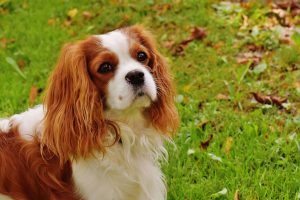Cavalier King Charles Spaniel
CKCS – Breed description

Also known as the Blenheim Spaniel, for the well-known lines bred at Blenheim Palace in the 1800s, the Cavalier might have had sedentary beginnings but it’s a very versatile dog. Owners will encounter an adorable pooch, as content to laze about the house as it is to join them on a countryside walk.
Cavalier King Charles Pros
- Friendly, affectionate and eager to please
- Gets on well with other dogs and children
Cavalier Cons
- May not be ideal for very active homes
- Susceptible to some health conditions
Cavalier King Charles Spaniels are suitable for
The CKCS is a great all-rounder, but we wouldn’t advise one for couples or families wanting to engage in very high levels of regular activity. It’s an adaptable breed, who is happy to relax with its owners in the house, but it’s well suited to a family home where it can get moderate daily exercise and some playtime, in exchange for providing plenty of love and affection.
- Homes with limited outdoor space
- Retired couples
- Families with young children
The Cavalier could make a wonderful addition to a home with young children, that is looking for a friendly, playful dog to incorporate into the family.
Cavalier care advice
An easy-going breed, the CKCS doesn’t need a large amount of breed-specific care. Owners should take care to provide these gentle dogs with opportunities to please, such as fun training sessions and playtime. They respond very well to positive reinforcement. These gentle dogs are very loving and live to satisfy their owners.
The Cavalier’s coat isn’t overly long, but more medium length. It doesn’t require a lot of maintenance but to avoid any knots or excessive grubbiness, it should be brushed through a couple of times each week, and, at the same time, the nails checked for any breaks or overly long lengths.
Known Cavalier health problems
The Cavalier is probably best known for its unfortunate susceptibility to heart disease. Chronic degenerative mitral valve disease (CDMVD) is recognised by the presence of a murmur in almost all dogs by old age, although not all will have clinical disease. Whilst present in many small breed dogs, CDMVD tends to start earlier in the Cavalier, and it’s always advisable to have any murmur checked out, to ensure it doesn’t reflect a serious problem. Regular follow ups also allow any signs of compromise or progression of the disease to be caught and treated sooner rather than later. CDMVD can lead to heart failure, causing abnormal accumulations of fluid in the lungs and abdomen, difficulty breathing, low exercise tolerance and poor function of the heart. There are ways to manage the signs and keep the dog comfortable, but it does tend to progress and severely affected dogs often need to be put to sleep because of the severity of their disease.
Another condition known to occur in Cavalier King Charles Spaniels is Syringomyelia (quite a mouthful, we know!). This is where abnormal bone formation at the back of the skull leads to an unusually narrowed space where the brainstem and cerebellum normally sit. This leads to obstruction to the flow of cerebrospinal fluid (which sits between the brain or spinal cord and their surrounding meningeal layers). It can lead to the cerebellum becoming herniated due to high pressure, which can be very serious. Although various degrees of disease are recognised, it may be present without the dog showing any clinical signs if it’s only mild. However, affected dogs often show signs like pain, discomfort, and scratching at the neck or ears, some will also have neurological signs, especially in the front legs. There are medical and surgical options available for treatment, depending on severity, but Syringomyelia may need lifelong or repeated management.
- CDMVD
- Luxating patella – abnormal anatomy in the knee means that the kneecap can slide out of place. This causes an abnormal skipping gait and, later on, painful arthritis
- Syringomyelia
- Primary secretory otitis media – the breed has been shown to suffer from middle-ear disease relating to an accumulation of mucus in the middle ear. This requires thorough (and sometimes repeated) cleaning through the ear drum, whilst under anaesthesia
- Retinal dysplasia and inherited cataracts – Cavaliers may inherit a propensity for cataract formation (clouding of the lens) or retinal dysplasia (abnormal structure of the retina, from where vision is generated). Both can lead to varying degrees of vision impairment.
Lead author: Yvette Bell MRCVS